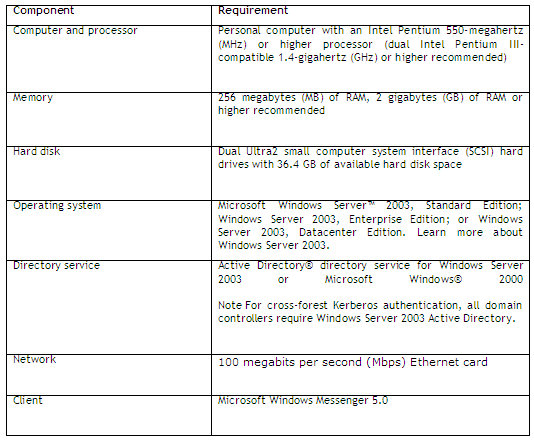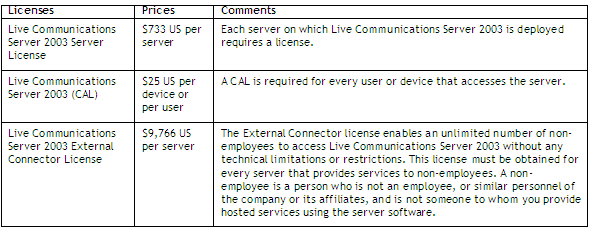Executive Summary
Introduction
Live Communication server enhances the power of Instant messaging and real-time communications to improve employee productivity. It is based on industry-standard protocol and offers secured messaging. It is an extensible system which enables the people to communicate and collaborate on various Medias.
A large party of people can communicate on the same business. LCS is built on Protocols such as Session Initiation Protocol (SIP) for Instant messaging and SIMPLE(Presence leveraging Extensions and a rich set of API's. LCS Integrates tightly with Windows 2003 Server to deploy and manage business critical information's. It provides a ways to integrate with existing Office applications.
Evolution of LCS
Microsoft exchange server 2000 provided its customers with enterprise Instant messaging service (based on RVP Protocol).This had initially met user's needs as expected. As the demand for extensibility grew, the RVP did not have a extending capabilities. Since the need for instant messaging grew, it was necessary for design an extensible platform, which lead to design LCS based on SIP.
Session Initiation Protocol (SIP) provides more security, greater depths of enhancing which allows reaching a wide range of applications. LCS uses SIP to effectively delivery presence information and communicate based on that on text, audio, video and data. LCS also provides API's for creation of custom application which make utilization of presence information and instant messaging.
SIP is an application layer control protocol which is used to create, modify and terminate such as Internet telephone calls and multimedia conferences. It works across the networks and devices and is an industry standard.
By building its platform on SIP, LCS has assured itself an extensible platform which will offer simple interoperability between applications for years to come.
Where can you use LCS?
- Information about User's Presence
- Instant messaging for higher degree of encryption.
- Integration of real-time communication with existing Office Tools.
- Collaborate on audio, video to share and exchange business ideas.
- Communication as desktop solution.
Technical Details
LCS Architecture

LCS sits on top of Microsoft Windows Server™ 2003 to serve various customers who can be reached on different clients like Desktop, laptop and smart clients.
LCS - Key Features
- Instant Messaging
Instant messaging is used to communicate in real time in an efficient manner. The instant messaging in LCS allows more than text exchange. It enables to do a audio, video exchange of information and to share a document or application. Using IM Improves productivity by reaching the right people at the right time.
- Integration with existing Office Products
LCS integrates tightly with Existing Office Products. Through IM which allows presence awareness indicator to indicate whether the team member is online, offline, busy, on phone, away or out to lunch. LCS adds more power to popular Office tools which is used for day to day activities. The Integration of LCS, Windows Messenger and the Office tools can also detect the user's presence on multiple devices based on the user's preferred mode of contact.
- Familiar GUI Look
LCS uses the GUI with which the user is already familiar with without having the enterprise spend on training the users. User can continue to use any one of the Messenger available like MSN Instant Messaging, Exchange IM and Live Communication Server without having to spend a lot of time on learning. Also GUI can be modified to suit the required changes for any organization by using the API's provided by LCS.
- User's Preferences
With the Option of user being available to collaborate on various media, it is necessary for user's preferences to be stored on server side. This enables the users to collaborate anytime, anywhere with great ease. LCS incorporates all these features.
- Modes of Collaboration
LCS allows to communicate and collaboration to be a part of every application through audio, video or text modes. When users are working on a document and have queries, they can share the document and discuss on this document and also both can make changes on the same document using IM. Also we can use Audio, Video modes of collaboration when the text mode does not provide the right information. User can also make PC2Phone or Phone2PC calls through PSTN(Public switched telephone network).With the Whiteboard feature , users can do conference, trainings as they do on regular whiteboards, this feature allows enterprise to save money on spent on training's and conferences.
- Archiving and Logging
This feature makes uses of LCS to Archive and Log the activities done during a real time communication which can be retrieved at a later point of time.
- Security
It is necessary that the communicated data to be secured enough to prevent the data reaching wrong hands. LCS allows encryption to the server using Transport Layer Security (TLS). This allows to protect valuable intellectual property by using authentication capabilities.
- Single Sign-on
LCS authorizes users using Active Directory, which simplifies the user management and prevents maintenance of users system within LCS. This Single Sign –on allows user to share same identity across multiple applications.
- Manageability
LCS can be managed using regular MMC snaps ins which also reduces the cost of training the system administrator and of course reduces the overall cost of system management.
- Scalability
LCS was designed keeping on mind enterprise level computing. LCS system is capable of handling 10,000 concurrent users per server with a dual processor 1.4 GHz and a 2 GB RAM according to Stress Test.
- API's
LCS allows developer community to access its features and functionality through API's. These API's allow to create multimodal communication applications, integrate presence information into the existing the application. It also developers to introduce additional security measures like virus checks etc into their system. It is allows to create intelligent applications for call routing and send messages to different devices based on time of day.
LCS - System Requirements

LCS - Licensing and Purchase Options
The Live Communications Server 2003 Standard Edition licensing model consists of a Server License and Client Access Licenses (CALs) and is designed to scale your costs in relation to your use. The tables below provide guidance on Live Communications Server 2003 license pricing and point you to licensing programs so you can find the most cost-effective solution for your organization.
Licenses Prices Comments

Case Studies from Microsoft
Case Study 1
Siemens Streamlines Communications and Cuts Costs with OpenScape :
Siemens is a world leader in a range of industries, including telecommunications and IT systems. Recognizing the convergence of IT and telephony technologies and the likely impact on some of its core businesses, Siemens wanted to create a product that could help both its own employees and other organizations gain a competitive advantage by vastly improving the speed and effectiveness of collaborative communications. Using Microsoft Office Live Communications Server 2003 as its platform, Siemens created OpenScape, a suite of customizable, extensible applications that help information workers use an expanded presence model that offers a real-time view of contacts' voice and instant messaging.
Case Study 2
Avanade Boosts Productivity by Moving to an Instant Messaging and Presence Standard :
Seeking to make itself more productive and, therefore, more competitive in the marketplace, Avanade chose Microsoft Office Live Communications Server 2003 as its real-time instant messaging standard, allowing employees throughout the enterprise to send and receive encrypted instant messages (IM) over its global network. This easy-to-deploy, highly manageable solution includes features such as integrated presence in the Microsoft Office System and custom line-of-business applications; logging and archiving capabilities; and customized, XML-based tabbing-all of which give users tools for conducting business more efficiently.